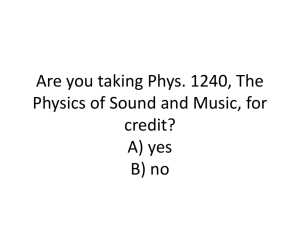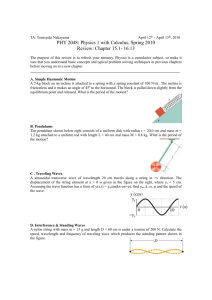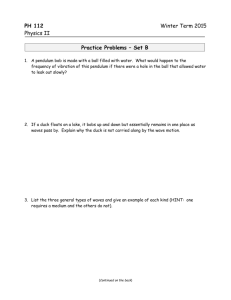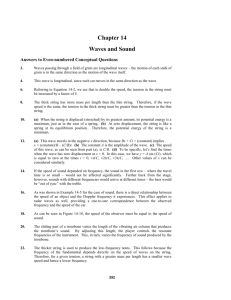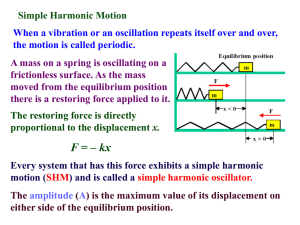P10
advertisement
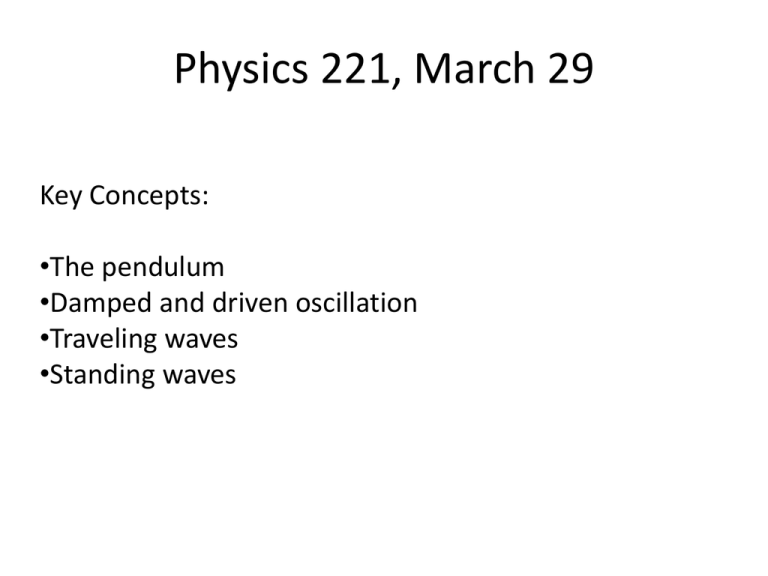
Physics 221, March 29 Key Concepts: •The pendulum •Damped and driven oscillation •Traveling waves •Standing waves The simple pendulum Hooke’s law: F = -kx x(t) = xmaxcos(ωt + φ)) Masses on springs obey Hooke’s law and their motion is simple harmonic motion. The pendulum: For a given displacement from equilibrium s = Lθ, the net force on the pendulum bob is F = -mgsinθ. For small displacements sinθ ~ θ, so we can write F = -mgθ = - (mg/L)*Lθ = -ks, with k = (mg/L) F obeys Hooke’s law. Hooke’s law simple harmonic motion s(t) = smaxcos(ωt + φ)) ω2 = k/m = g/L , f = 1/T Extra credit: A simple pendulum consists of a point mass m suspended by a massless, unstretchable string of length L. If the mass is doubled while the length of the string remains the same, the period of the pendulum 1. 2. 3. 4. 5. becomes 4 times greater. becomes twice as great. becomes greater by a factor of square root of 2. remains unchanged. decreases. 0% 1 0% 2 0% 3 0% 4 30 0% 5 A simple pendulum of length L oscillates back and forth 10 times per second. By what factor do you have to change its length to make it oscillate back and forth only 5 times per second. 1. 2. 3. 4. 5. 6. Increase the length by a factor of √2. Increase the length by a factor of 2. Increase the length by a factor of 4. Decrease the length by a factor of √2. Decrease the length by a factor of 2. Decrease the length by a factor of 4. 30 0% 0% 0% 0% 0% 0% 1 2 3 4 5 6 A simple pendulum of length L oscillates back and forth 10 times per second. By what factor do you have to change its length to make it oscillate back and forth only 5 times per second. • • • • Original frequency: Original period: Desired frequency: Desired period: 10/s (1/10)s 5/s (1/5)s You want to double the period. You must increase L by a factor of 4. Link: Pendulum Waves Damped oscillations Free oscillations of macroscopic systems damp out. If the total force on the damped system is F = -kx – bv, then the motion of the system is given by x(t) = A0exp(-bt/2m)cos(ωdampt + φ), with ωdamp2 = k/m - (b/2m)2. The energy stored in the system is proportional to the square of its amplitude, it decreases as E = E0exp(bt/m). A -> A0/2 implies E -> E0/4 You are watching a mass oscillate on a spring. The initial amplitude is 10 cm. You measure the period to be a constant 1.1 s. The energy E stored in the oscillating system halves after 10 s. How long does it take for the amplitude of the oscillation to decrease to 5 cm? 1. 2. 3. 4. 5s 10 s 20 s 40 s 0% 1 0% 2 0% 3 0% 4 30 Forced oscillations Assume we have a damped harmonic oscillator acted on by a driving force F0cos ωextt . The net force acting on the oscillator is F = F0cosωextt - kx – bv. The resulting motion is x(t) = Acos(ωextt + φ). The amplitude of forced oscillations is small unless the driving frequency is close to the natural frequency. When the driving frequency is equal to the natural frequency the amplitude of the oscillations can be become very large - this is called resonance. http://www.acoustics.salford.ac.uk/feschools/waves/wine3video.htm Consider a tractor driving across a field that has undulations at regular intervals. The distance between the bumps is about 4.2 m. Because of safety reasons, the tractor does not have a suspension system but the driver’s seat is attached to a spring to absorb some of the shock as the tractor moves over rough ground. The natural frequency of the driver and the seat is f = 2 Hz. At what speed does the drive become dangerous? 1. 2. 3. 4. 2.1 m/s = 4.7 mph 4.2 m/s = 9.4 mph 8.4 m/s = 18.8 mph 12.6 m/s = 28.2.8 mph 30 0% 1 0% 2 0% 3 0% 4 The distance between the bumps is about 4.2 m. The natural frequency of the driver and the seat is f = 2 Hz. At what speed does the drive become dangerous? The drive becomes dangerous when the frequency with which the tractor encounters the bumps equals the natural frequency of the driver and the seat, or when the time interval between hitting the bumps equals the natural period. f = 2 Hz = 2/s, T = 0.5 s. v = 4.2 m / T = 8.4 m/s. Traveling waves Periodic, sinusoidal waves in one dimension: The displacement as a function of position and time is given by y(x,t) = A sin(kx - ωt + φ) for a wave traveling in the +x direction, and by y(x,t) = A sin(kx + ωt + φ) for a wave traveling in the -x direction. k is the wavenumber, k = 2π/λ. ω = 2π/T = 2πf is the angular frequency. φ is called the phase constant. λ = wavelength, f = frequency, T = period, v = λ/T = λf = ω/k = speed. The energy E transported by the wave is proportional to A2. The power P is proportional to A2v. For waves on a string: Extra credit: A wave travelling in the +x direction is described by the equation y = 0.1 sin (10 x − 100 t) where x and y are in meters and t is in seconds. Calculate (i) the wavelength, (ii) the period, (iii) the speed, and (iv) the amplitude of the wave 1. 2. 3. 4. (i) 10 m, (ii) 0.100 s, (iii) 1 m/s, (iv) 0.1 m (i) 0.63 m, (ii) 15.9 s, (iii) 10 m/s, (iv) 0.2 m (i) 0.1 m, (ii) 0.01 s, (iii) 10 m/s, (iv) 0.1 m (i) 0.63 m, (ii) 0.063 s, (iii) 10 m/s, (iv) 0.1 m 0% 1 0% 2 0% 3 0% 4 30 Extra point: If you double the wavelength λ of a wave on a string under fixed tension, what happens to the wave speed v and the wave frequency f? 1. 2. 3. 4. 5. v is doubled and f is doubled. v is doubled and f is unchanged. v is unchanged and f is halved. v is unchanged and f is doubled. v is halved and f is unchanged. 0% 1 0% 2 0% 3 0% 4 0% 5 30 A travelling wave is described by the equation y(x,t) = (0.003) cos(20 x + 200 t ) where y and x are measured in meters and t in seconds What is the direction in which the wave is travelling? 1. The + x direction 2. The –x direction 3. This is a standing wave 0% 1 0% 2 0% 3 30 Which of the following wave functions describe a wave that moves in the -x-direction? 1. 2. 3. 4. 5. y(x,t) = A sin (–kx – ωt) y(x,t) = A sin (kx + ωt) y(x,t) = A cos (kx + ωt) both 2. and 3. all of them 0% 1 0% 2 0% 0% 3 4 0% 5 30 The four strings of a musical instrument are all made of the same material and are under the same tension, but have different thicknesses. Waves travel 1. 2. 3. fastest on the thickest string. fastest on the thinnest string. at the same speed on all strings. 0% 1 0% 2 0% 3 30 Standing waves on a string For a string fixed on both ends a standing wave forms when an integral number of half wavelengths fit into the length of the string. Extra credit: A particular violin string plays at a frequency of 440 Hz. If the tension is increased by 8.0%, what is the new frequency? 1. 2. 3. 4. 5. 440 Hz 407 Hz 475 Hz 423 Hz 457 Hz 0% 1 0% 2 0% 3 0% 4 0% 5 30
